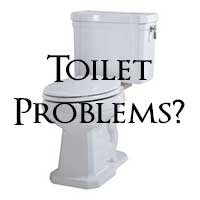 Ah, the good ‘ole John in all of its glory. Let’s be real – if the toilet quits working, we’re in heaps of trouble and need it fixed quickly. Out of the myriad of plumbing concerns, experiencing issues with the toilet has got to be at the top of the list. Let’s take a look at a few common toilet problems households face every day and some troubleshooting you can do on your own to alleviate these problems. Of course, if all else fails or you are unsure how to execute solutions noted in this troubleshooting guide, contact your New Jersey Roto-Rooter to have an experienced professional plumber dispatched to your home. Keep in mind, toilet tank components will vary in design and layout, as new materials and technologies continue to advance plumbing fixtures and mechanisms – and the toilet is no exception. With that said, much of the troubleshooting guide below can be applied to most toilets and their inner workings.
Ah, the good ‘ole John in all of its glory. Let’s be real – if the toilet quits working, we’re in heaps of trouble and need it fixed quickly. Out of the myriad of plumbing concerns, experiencing issues with the toilet has got to be at the top of the list. Let’s take a look at a few common toilet problems households face every day and some troubleshooting you can do on your own to alleviate these problems. Of course, if all else fails or you are unsure how to execute solutions noted in this troubleshooting guide, contact your New Jersey Roto-Rooter to have an experienced professional plumber dispatched to your home. Keep in mind, toilet tank components will vary in design and layout, as new materials and technologies continue to advance plumbing fixtures and mechanisms – and the toilet is no exception. With that said, much of the troubleshooting guide below can be applied to most toilets and their inner workings.
Problem 1: The Water In The Tank Runs Constantly
If you are experiencing issues with water in your tank running constantly, you could have a problem with the float ball, the tank ball or the ballcock valve. If your problem appears to be that the float ball or rod is misaligned or that the float ball is not rising high enough, you can try bending the float rod down slightly (carefully), so that it rises high enough, or to a position that prevents the ball from rubbing against the side of the tank. You should also check the float ball to see if it contains water; if so, you will need to empty and possibly replace the float ball. If your float ball is not the origin of the problem, then a quick look at your tank ball and ballcock valve should answer your questions. If the tank ball is not sealing properly at the bottom of the tank you can remove any corrosion from around the lip of the valve seat or try adjusting the lift wire and guide. If the tank ball is completely worn out, you may need to replace this altogether. If you find that your ballcock valve is not shutting off the water, then you may want to try replacing the washers in the ballcock assembly or replacing the entire assembly if needed.
Problem 2: The Toilet Does Not Flush Adequately
When the toilet does not flush properly, you could be looking at a clogged drain or ports, inadequate water supply in tank, improper tank ball functioning or a leak in the tank and bowl joint. The obvious solution to a clogged drain or port is to remove the blockage or build-up of residue and see if this fixes the problem. If not, you may need to move your guide up, so that the tank ball can rise slightly higher, ensuring an adequate amount of water is allowed to leave the tank before the tank ball falls back into place. If you are experiencing a leak where the tank joins the toilet bowl, you’ll need to adjust and tighten the nuts on the spud pipe and in some cases replace the spud washers.
Problem 3: The Tank Makes a Whining Noise When It’s Flushing
If you notice a problem with a noisy toilet while the tank is filling, then you may a restricted water supply or the ballcock valve on your toilet may not be operating properly. To check for a restricted water supply, inspect your shutoff valve to ensure it is completely open and also check for corrosion or build-up along the valve entrance. If your problem is ballcock valve related, check to see if you need to replace the washers or the ballcock assembly altogether.
Problem 4: There Is Moisture Around The Toilet Fixture
Moisture around the toilet fixture is a very common problem which can be causes by condensation, leaking, or a crack in the fixture. If condensation is the issue, you can install a foam liner, drip catcher, tank cover and/or temperature valve to alleviate this headache. However, leakages and cracks require a thorough inspection of the flange wax seal, the joint between the bowl and the tank, the water inlet connection and the toilet fixture as a whole. A replaced wax ring seal will mend a leak in the flange wax seal, where tightening spud pipe nuts and replacing worn spud washers will repair a leak between the bowl and the tank. If you find a leak at the water inlet connection, you should tighten the locknut and coupling nut and, in some cases, replace the washers and gasket. When you’ve got a crack in the tank or the toilet bowl, your only option is to replace the entire toilet fixture or individualized component that is cracked.
For help with any toilet problem or plumbing need contact our office for quick and friendly service from your New Jersey Plumbers at Roto-Rooter.
